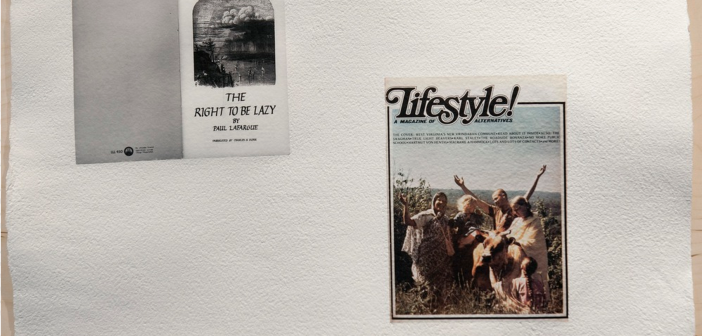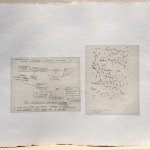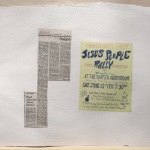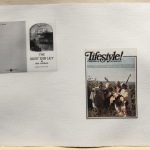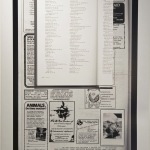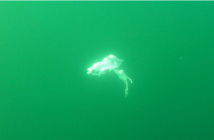As an artist in an archive—drawing from the Alternative Press Collection at the University of Connecticut—Louise Menzies has taken a particular scattered history and out of it, created for this concise, evocative exhibition a collection of paper reliquaries that embed, like insects in amber, traces of a time that did not lack for either conviction or intensity.
A New Zealand artist long interested in print and film media, Menzies, as a conclusion to an extended residency, fashioned the exhibition as a time specific exercise, mirroring the nature of the archival materials that would be incorporated in it. The counter cultural pamphlets, revolutionary flyers and activist newsletters she selected, ephemeral by definition, were copied digitally, then suspended in a slurry of pulp. As the paper-making screen was raised from beneath the material, the artist literally brought her chosen fragments to the surface, with the illusion of the original trapped and isolated in another medium.
The pieces which result emerge briefly as objects in their own right: a rendering of a university president’s speech as a Dada jumble exquisitely suited to the depiction of bureaucratic nonsense; a Dorothea Lange photograph of a Depression-era woman, hand to her forehead, reprinted on the cover of a 1971 feminist political journal. But these are not the heart of the matter, whatever issues they may raise regarding the appropriation of traditional political documentary and satire. The exhibition is the sum of its parts, rather than a discrete collection of individual objects. Whatever the artist's process of discrimination may have been, it is possible to imagine a different series of choices having equal relevance to the larger question that comes across as most urgent in this work: not of how history is to be recorded, but how it is to be reimagined.
It is an obvious irony that the very system which the creators of these documents largely opposed, has now given these same documents institutional sanction. The materials have been preserved, surely, but drained of the immediacy and passion that originally produced them. What Menzies looks to do is invent a new present content for these records. Her process of selection creates a whimsical archive, mysterious in regard to its motives, unconstrained by the footnoted myths of scholarship. The forthright subjectivity of her choices produces a narrative determined solely by the artist, and not the archive. Menzies’ ability to fashion a private history highlights the difference between her celebration of vibrant activism and some mere documentation of it.
Alongside these paper fragments, Menzies has installed The Press, Kodak Eastman 5222, a 16mm film loop she created in 2013. Like Charlie Chaplin threaded through his Modern Times machinery, here the news is an exercise in mass production for a mass audience. But the newspapers that were once vehicles of history have now become history's subjects, and their presses are the obsolete remains of a literate worldview.
The notion of an alternative press from which the examples for this exhibit were drawn was once real, because there was a traditional print media for it to judge and correct. But the multiplication of voices in the internet world has substituted ideological cant for social criticism, and measures its success with the most expedient lies from the most attractive purveyors.
Among these materials that Menzies has gathered there is a sense of the truth needing to be discovered, even if it meant taking responsibility for changing the world that truth described. If the exhibition has an activist consequence, it is not entirely clear whether that is as inspiration to carry on such advocacy, or despair that anything like it could ever be managed again.
The audience for this exhibition will necessarily be divided by generations. It cannot be merely a problem of historical research for those who, like this writer, were contemporaries of the voices revisited here and cannot see these fragments free from a sense of their own history vanished. For them there is no escaping the insight that, in these darkened remains of what once was bright, their youth has become the past.
Louise Menzies was artist in residence this fall at the University of Connecticut. The resulting exhibition Time to Think Like a Mountain was on view at the University's Contemporary Art Galleries, October 8 through November 21, 2014
contemporaryartgalleries.uconn.edu
- Louise Menzies “Connecticut’s interlocking corporate structure and Homer Babbidge’s companions — an unfinished portrait,” APC file: Student Movement and Demonstration — Connecticut. University. [1968-1969] folder no. 3 “SDS version of President Babbidge’s statements,” APC file: Student Movement and Demonstration — Connecticut. University. [1968-1969] folder no. 3 2014 Archival inkjet prints embedded in handmade paper
- Louise Menzies “Connecticut’s first Jesus People rally,” APC file: Jesus People. Poster “Religion: Read About the Heavy Solution,” APC file: Jesus People newspaper clipping. 2014 Archival inkjet prints embedded in handmade paper
- Louise Menzies Paul Lafargue, “The Right to Be Lazy,” Chicago: Solidarity Publications. 1969. “Lifestyle!,” Mother Earth News, no. 16. Insert. Front cover. 2014 Archival inkjet prints embedded in handmade paper
- Louise Menzies Earth First! June 21, 1986. p. 28 2014 Archival inkjet print

